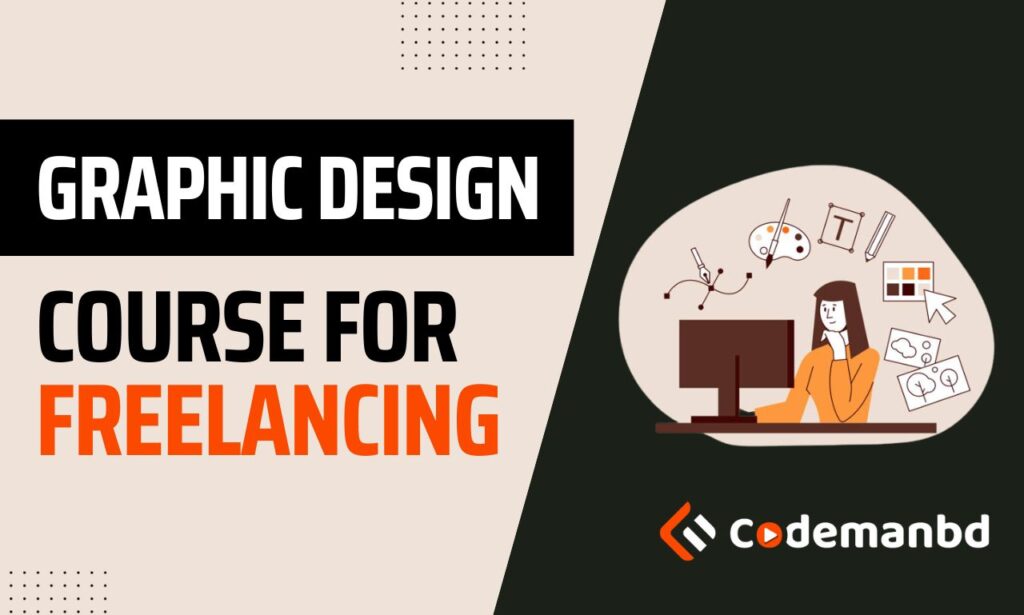Looking to pursue a Graphic Design Course in Bangladesh? Check out the top online graphic design courses available from reputable institutions like CodemanBD, Creative IT Institute, Coderstrust Bangladesh.
These courses offer comprehensive training in graphic design theory, software skills, and portfolio development, and some even provide certifications upon completion. Whether you are a beginner or looking to advance your skills, these courses cater to individuals at various levels of expertise.
Additionally, you can start learning graphic design in Bangladesh by mastering the basics, taking online courses, familiarizing yourself with design programs, building a portfolio, networking, gaining work experience, and continuously learning and growing in the field.
Understanding The Basics Of Graphic Design

It all starts with a solid foundation in graphic design for creative a visually appealing design. Understanding the basics of graphic design is essential for anyone looking to pursue a career in the creative field. In this article, we will explore the key concepts and principles that form the backbone of graphic design, including what it is and why it is significant. Whether you are a beginner or someone looking to sharpen their design skills, mastering these basics will lay the groundwork for your success.
What Is Graphic Design And Its Significance?
Graphic design is the art of creating visual content to communicate messages effectively. It is the process of combining visuals, typography, colors, and other elements to convey a specific message or evoke a desired emotion. Graphic design plays a crucial role in various industries, including marketing, advertising, web design, and branding.
If you are wondering why graphic design is significant, consider this – visuals have a powerful impact on human perception and memory. By using well-designed graphics, businesses can capture the attention of their audience and leave a lasting impression. Effective graphic design can help in building brand identity, improving user experience, and enhancing communication.
Key Principles Of Graphic Design
There are several principles that graphic designers follow to create visually appealing and functional designs. Let’s take a closer look at some of the key principles:
- Balance: Achieving a sense of balance in a design is crucial. It involves the distribution of visual elements, such as color, shape, and text, to create a harmonious and aesthetically pleasing composition.
- Hierarchy: Establishing a clear hierarchy allows designers to guide the viewer’s attention. By organizing and prioritizing visual elements, designers can effectively communicate the intended message.
- Typography: The careful selection and arrangement of typography have a significant impact on how a design is perceived. Choosing appropriate fonts and utilizing typography techniques can enhance readability and convey the desired tone.
- Color theory: Colors evoke emotions and play a vital role in design. Understanding color theory helps designers create visually appealing and cohesive designs that resonate with the intended audience.
- Contrast: Contrast allows designers to highlight important elements and create visual interest. By using contrasting colors, sizes, or shapes, designers can guide the viewer’s attention and create visual impact.
- Alignment: Ensuring elements are properly aligned helps create a polished and professional look. Proper alignment enhances readability, organization, and visual cohesion.
By mastering these key principles, graphic designers can create captivating designs that effectively communicate messages and achieve desired objectives.
Choosing The Top Graphic Design Course in Bangladesh

Are you considering a freelancing career in graphic design? With the ever-growing demand for talented designers in various industries, it’s crucial to choose the right graphic design course to kick-start your journey. The top and right course in Bangladesh can provide you with the knowledge, skills, and experience needed to excel in this competitive field. But with so many options available, how do you choose the top graphic design course in Bangladesh that matches your aspirations and learning preferences?
Factors To Consider When Selecting A Top Graphic Design Course
Before you make a decision, it’s important to consider a few key factors that can impact your learning experience and future prospects. Here are some factors to keep in mind:
- Course curriculum: Look for a course that covers the essential aspects of graphic design such as color theory, typography, layout design, digital illustration, and software proficiency. Ensure that the course aligns with your learning goals and covers the areas you are most interested in.
- Instructor qualifications: The expertise of the instructors can significantly impact your learning experience. Look for courses taught by experienced professionals who have a strong background in the graphic design industry. Research their credentials and consider their industry experience and teaching methods.
- Learning resources: Check if the course provides access to a wide range of learning resources such as textbooks, online tutorials, design software, and industry-specific tools. Learning materials should be up-to-date and relevant to the current trends in the graphic design field.
- Practical projects and assignments: Practical, hands-on projects and assignments are vital for developing your design skills. Ensure that the course offers ample opportunities to apply your knowledge through real-world projects, client briefs, and portfolio-building exercises.
- Flexibility and schedule: Consider your availability and learning style. Look for courses that offer flexible schedules, allowing you to learn at your own pace. Online courses can be a great option for those who prefer self-paced learning and need the flexibility to study from anywhere.
Top Graphic Design Courses In The Market
If you’re looking for some reputable graphic design courses in the market, here are a few options worth considering:
| Course Name | Provider |
| Freelancing with Graphic Design | CodemanBD |
| Graphic Design | Creative IT Institute |
| Free Graphic Design Course for Beginners: Adobe Illustrator, Adobe Photoshop, Adobe InDesign | Udemy |
Remember to thoroughly research these courses, read reviews, and evaluate their suitability based on your specific needs and preferences. Keep in mind that everyone’s learning journey is unique, so what works for others may not necessarily work for you.
Choosing the top graphic design course in Bangladesh can be a stepping stone towards a successful career in the design industry. By considering the course curriculum, instructor qualifications, learning resources, practical projects, and flexibility, you can make an informed decision that aligns with your goals and aspirations. Take the time to explore the available options and choose the course that best suits your learning style and helps you develop the skills necessary to thrive as a graphic designer.
Exploring Modules And Curriculum
Pursuing a graphic design course, understanding the modules and curriculum is essential. These components form the foundation of your learning journey, equipping you with the necessary knowledge and skills to excel in this field. In this section, we will dive into the essential modules covered in a graphic design course and take an in-depth look at the curriculum and learning objectives.
Essential Modules Covered In A Graphic Design Course
A comprehensive graphic design course covers a range of essential modules that provide a well-rounded education in this creative field. These modules equip students with the necessary skills to thrive in various aspects of graphic design. Here are some key modules commonly included:
- Introduction to Graphic Design: This module serves as the foundation, introducing students to the principles, elements, and history of graphic design. Students gain an understanding of the industry’s dynamics and the role of a graphic designer.
- Typography: Typography plays a crucial role in design, and this module delves into the art and science of typefaces. Students learn about font selection, hierarchy, and effective typography techniques to enhance visual communication.
- Color Theory: Understanding the psychology and use of color is vital in graphic design. This module explores color relationships, color schemes, and their impact on emotions and perceptions.
- Layout and Composition: Effective arrangement and composition are key to creating visually appealing designs. This module focuses on grid systems, visual balance, and the use of white space to achieve harmonious layouts.
- Logo Design: Logos are symbolic representations of brands, and this module delves into the art of creating memorable and meaningful logos. Students learn about logo design principles, brand identity, and how to ideate and execute successful logos.
- Print Design: This module explores the world of print media, covering topics like flyer design, poster design, packaging design, and print production techniques. Students gain knowledge of industry standards and printing processes.
- Web Design: With the digital age, web design has become an integral part of graphic design. This module introduces students to web design principles, user experience (UX) design, responsive design, and the basics of coding.
- Image Editing: Graphic designers often work with images, and this module focuses on image editing techniques using popular software like Adobe Photoshop. Students learn how to enhance photos, manipulate images, and create visually appealing compositions.
In-depth Look At The Curriculum And Learning Objectives
The curriculum of a graphic design course is carefully crafted to ensure comprehensive learning and skill development. Let’s take a closer look at the curriculum and the associated learning objectives:
| Module | Learning Objectives |
| Introduction to Graphic Design |
|
| Typography |
|
| Color Theory |
|
| Layout and Composition |
|
| Logo Design |
|
| Print Design |
|
| Web Design |
|
| Image Editing |
|
By structuring the curriculum around these modules and defining clear learning objectives, graphic design courses ensure that students gain a comprehensive understanding of the field, along with the practical skills needed to succeed in the industry.
Learning The Tools Of The Trade

Having a strong foundation in the tools of the trade is essential. From creating stunning visuals to manipulating images, having a comprehensive understanding of graphic design software and tools can set you apart in this competitive industry. In this section, we will explore the popular graphic design software and tools that you will be introduced to during a Graphic Design Course.
Introduction To Popular Graphic Design Software And Tools
During your Graphic Design Course, you will be introduced to a range of industry-standard software and tools that are widely used by professionals in the field. These software and tools not only enhance your design capabilities but also enable you to create visually appealing and impactful designs. Here are some of the popular graphic design software and tools you can expect to learn:
- Adobe Illustrator: This vector-based software is a staple in the graphic design industry. In your course, you will learn how to use Illustrator to create scalable and high-quality illustrations, icons, logos, and more.
- Adobe Photoshop: Known for its powerful image editing capabilities, Photoshop is essential for retouching photos, creating digital artwork, and designing web graphics. During your course, you will gain hands-on experience with Photoshop’s tools and techniques.
- Adobe InDesign: InDesign is the go-to software for designing layouts for print and digital publications. You will learn how to create professional-looking brochures, magazines, and e-books using InDesign’s advanced features.
- Gravit Designer: A user-friendly vector design software, Gravit Designer allows you to work on a wide range of design projects. You will explore its tools and functions to create illustrations, logos, and web graphics.
- Affinity Designer: Affinity Designer is a powerful alternative to Adobe Illustrator. By learning this software, you will have versatile options for creating vector illustrations, typography, and branding materials.
- Sketch: Widely used by UI/UX designers, Sketch is known for its intuitive interface and extensive design toolkit. During your course, you will gain skills in creating user interfaces and interactive prototypes using Sketch.
Hands-on Experience With Industry-standard Applications
To ensure you have a comprehensive understanding of these graphic design software and tools, your course will provide hands-on experience with industry-standard applications. Through practical exercises and projects, you will have the opportunity to apply your knowledge and hone your design skills.
By gaining practical experience with these tools, you will develop the confidence and expertise needed to tackle real-world graphic design projects. This hands-on approach will also allow you to build a strong portfolio that showcases your ability to use these software and tools effectively.
Remember, learning the tools of the trade is just the first step in becoming a successful graphic designer. Alongside technical skills, creativity and a keen eye for design are equally important. So, as you dive into your Graphic Design Course, embrace the opportunity to learn and experiment with these popular software and tools – they are your gateway to unlocking your potential as a graphic designer.
Developing Design Skills And Techniques
Developing strong design skills and techniques is essential for creating visually appealing and impactful designs. In this blog post, we will explore two key aspects of design that every graphic designer must master: color theory and typography.
Mastering The Art Of Color Theory
Color is a powerful tool in graphic design. Understanding how different colors work together and evoke emotions is essential for creating harmonious and visually appealing designs. By mastering the art of color theory, designers can effectively communicate a brand’s message and create memorable experiences for their audience.
- The color wheel, which helps designers understand the relationships between different colors.
- The psychology of color, which explores how colors can evoke specific emotions and associations.
- Color harmony, which involves selecting colors that complement each other and create a visually balanced composition.
By applying these principles, designers can create designs that not only look aesthetically pleasing but also effectively convey the desired message to the target audience.
Techniques To Create Visually Appealing Designs
Typography plays a crucial role in graphic design as it involves the art and technique of arranging type to make written language readable and visually appealing. Well-executed typography can elevate the overall design and ensure a seamless reading experience for the audience.
Here are some techniques for creating visually appealing designs using typography:
- Choosing the right typefaces: Selecting appropriate typefaces that match the brand’s personality and effectively communicate the message is crucial.
- Consider hierarchy: Establishing a clear hierarchy within the typography helps guide the reader’s attention and emphasizes important information.
- Experimenting with text formatting: Using techniques like kerning, leading, tracking, and line spacing can enhance the readability and visual appeal of the text.
- Pairing typefaces: Combining complementary typefaces can create contrast and visual interest.
By utilizing these typography techniques, designers can create designs that are not only visually appealing but also effectively communicate the intended message to the audience.
Creating A Stellar Portfolio
Having a standout portfolio is essential. A well-curated portfolio not only demonstrates your expertise and creativity but also acts as a visual representation of your unique style and capabilities. In this blog post, we will explore the importance of a well-curated graphic design portfolio and provide you with some tips on how to effectively showcase your best work.
Importance Of A Well-curated Graphic Design Portfolio
A well-curated graphic design portfolio serves as a powerful marketing tool that helps you leave a lasting impression on potential clients or employers. It showcases your skills, experience, and ability to solve design problems. Here are some reasons why having a stellar portfolio is crucial for your graphic design career:
- Credibility: A portfolio demonstrates your expertise and credibility as a graphic designer. It showcases your ability to produce high-quality designs and effectively communicate messages through visual mediums.
- Showcasing your style: Your portfolio allows you to showcase your unique style and creative approach to design. It helps potential clients or employers understand your aesthetic preferences and whether your style aligns with their needs.
- Evidence of experience: Your portfolio acts as evidence of your experience and the projects you have worked on. It displays the diverse range of clients and industries you have collaborated with, giving potential clients or employers confidence in your abilities.
- Professionalism: A well-curated portfolio demonstrates your professionalism and attention to detail. It showcases your ability to organize and present your work in a visually appealing and organized manner.
- Competitive advantage: In a highly competitive industry, a stellar portfolio can give you a competitive edge over other designers. It helps you stand out and leaves a lasting impression on potential clients or employers.
Tips For Showcasing Your Best Work Effectively
Now that we understand the importance of a well-curated graphic design portfolio, let’s explore some tips to help you showcase your best work effectively:
- Curate and organize: Be selective in choosing which projects to include in your portfolio. Include a diverse range of work that showcases your versatility and breadth of skills. Organize your portfolio in a logical and easy-to-navigate manner, grouping similar projects together.
- Highlight your process: Include sketches, mock-ups, or any behind-the-scenes work that showcases your design process. This gives potential clients or employers insight into your problem-solving skills and creative thinking.
- Provide context: Briefly describe each project, including the client’s goals, challenges, and your design solution. This helps viewers understand the context and impact of your work.
- Showcase variety: Include a variety of design projects, such as branding, print, web, and illustration, to showcase your diverse skill set and expertise in different areas.
- Focus on quality: Only include your best work in your portfolio. Quality over quantity is crucial. Showcasing a few outstanding projects will leave a stronger impression than overwhelming viewers with mediocre designs.
- Keep it up to date: Regularly update your portfolio to reflect your latest and most relevant work. Remove outdated projects and replace them with recent ones to demonstrate your continued growth and improvement as a designer.
By following these tips, you can ensure that your graphic design portfolio effectively showcases your skills, style, and expertise, while leaving a lasting impression on potential clients or employers. Remember, a stellar portfolio is your passport to new opportunities in the world of graphic design!
Exploring Career Opportunities In Graphic Design
Graphic design is a dynamic and creative field that offers diverse job prospects for individuals with a passion for visual communication. Whether you have just completed a graphic design course or are considering entering this exciting industry, understanding the range of career opportunities available is essential for making informed decisions about your professional path. In this article, we will explore the wide range of job prospects in the field of graphic design and what you can expect after completing a graphic design course.
Diverse Job Prospects In The Field Of Graphic Design
Graphic design offers a wide range of exciting career paths, allowing professionals to explore their creativity while making a significant impact in various industries. Let’s take a look at some of the diverse job prospects in graphic design:
- Graphic Designer: As a graphic designer, you will have the opportunity to work on projects ranging from logo design and brand identity development to creating visually compelling layouts for print and digital media.
- Art Director: If you have a keen eye for aesthetics and a knack for creative direction, a career as an art director may be ideal for you. Art directors oversee the visual aspects of projects, ensuring cohesive and visually appealing designs.
- UI/UX Designer: In today’s digital age, user experience and user interface design are integral parts of creating successful websites, apps, and digital products. As a UI/UX designer, you will focus on creating intuitive and visually pleasing interfaces.
- Web Designer: With the increasing demand for visually engaging websites, web designers play a crucial role in creating user-friendly and visually appealing online experiences. You will collaborate with developers to bring designs to life.
- Print Production Artist: If you have a love for the physical aspect of design, becoming a print production artist allows you to bring designs to life in print form. You will work closely with printers to ensure accurate reproduction of your designs.
- Brand Identity Specialist: Brand identity specialists specialize in crafting compelling visual identities for businesses. From logo design to typography selection, your role will be instrumental in establishing and maintaining brand consistency.
What To Expect After Completing A Graphic Design Course
Completing a graphic design course opens the doors to numerous opportunities in the creative industry. Here’s what you can expect:
- A strong foundation in design principles, typography, color theory, and visual communication.
- Proficiency in industry-standard software such as Adobe Photoshop, Illustrator, and InDesign.
- A diverse portfolio showcasing your design skills and creativity, which plays a vital role in securing employment or freelance projects.
- An understanding of the design process, from initial concept development to the final execution of projects.
- Opportunities to collaborate with other designers, clients, and creative teams, allowing you to enhance your communication and teamwork skills.
- Access to industry insights, trends, and best practices through networking events, workshops, and online communities.
By completing a graphic design course, you are equipped with the necessary skills and knowledge to embark on a successful career in graphic design. Whether you choose to work for an agency, become a freelance designer, or start your own design studio, the opportunities are vast.
If you have a passion for creativity and visual communication, exploring career opportunities in graphic design can lead to a fulfilling and dynamic professional journey.
Upskilling And Continuous Learning
In the rapidly evolving field of graphic design, upskilling and continuous learning are critical for staying relevant and competitive. With technological advancements and changing design trends, it is essential for graphic designers to acquire new skills, expand their knowledge, and adapt to the latest industry practices. Here are some effective strategies for staying updated with the latest design trends and exploring advanced courses and certifications:
Strategies For Staying Updated With The Latest Design Trends
To stay at the forefront of the industry, graphic designers must keep a pulse on the latest design trends. Here are some strategies to help you stay updated:
- Follow design blogs and websites that curate and share the latest design inspiration, trends, and tutorials.
- Join relevant online communities and forums where designers discuss and share insights about current trends.
- Engage with social media platforms, especially design-focused ones like Behance, Dribbble, and Instagram. Follow influential graphic designers and industry leaders to see their work and stay informed.
- Attend design conferences, workshops, and meetups to gain exposure to new ideas and network with professionals in the field.
- Subscribe to industry newsletters and publications to receive regular updates and insights from design experts.
Conclusion
Dedicated students can greatly accelerate the process of learning graphic design skills. By learning the basics, building skills through online courses, mastering design programs, and creating a portfolio of projects, one can become a proficient graphic designer. It is important to continue learning and growing, as well as gaining work experience and expanding your network.
With determination and dedication, anyone can succeed in the field of graphic design.









